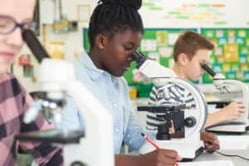Continental Drift Theory Inquiry Lab
Middle School Inquiry Lab on Continental Drift Theory
In this lab, students will explore artifacts supporting continental drift theory, then model continental drift.
Each inquiry lab will contain an essential question that will drive the lessons and make students think. For this lesson, the essential question is:
- How does the historical development of evidence support the theory of plate tectonics?
BACKGROUND INFORMATION AND MATERIALS LIST:
Students will begin the lab by reading the essential question and background information. This can be done individually, as lab groups, or as a whole class. Personally, I would do it in lab groups and then do some whole class formative checks before digging into the lab.
Materials List:
- safety equipment (goggles)
- Pangaea-to-modern cards
- mini drifting continents
- colored pencils
- 1 cereal bowl
- shaving cream (2" dollop)
- waxed paper (3" larger than bowl)
- cooking spray
PROCEDURE:
Students will complete three tasks related to showing evidence that the continents are moving. The first activity has students using a set of four cards, supplied with the lab, to place in order from oldest map to the most present map showing the placement of continents throughout history.
Secondly, students will see how magnetometers show the formation of new crust at the Mid-Atlantic Ridge. Using contrasting-colored pencils, students will color in sections of the seafloor showing how over time new crust is pushing up out of the sea floor. Contrasting colors will also indicate to students the discovery of the polarity and reverse polarity of the Earth's magnetism.
Finally, students will be able to see what happened to the continents over millions of years, in just seconds. Using a bowl, wax paper, shaving cream, and the mini continents provided, students will see what Harry Hess discovered as he used sonar to map the ocean floor. As the continents move, and the shaving cream fills the empty space, students are able to see how the crust is constantly changing the way the continents are located.
CHECK FOR UNDERSTANDING:
At this point in the lab, students will be checked for understanding by answering questions about their findings. Here are a few that come with the lab:
- What sections of the seafloor are the newest, meaning they were liquid magma more recently that the other areas?
- In real life, heat from the core causes magma under the crust to flow in circles called convection currents. The motion carries the plates in different directions, sometimes pushing them together and sometimes pushing them apart. What caused the magma to move in this lab?
CONCLUSION
Students will go back to the essential question and write a CER (Claim, Evidence, Reasoning) to conclude the lab. Once completed, students will reflect back on their learning by answering the following questions:
- On what evidence did Alfred Wagener build his theory of continental drift?
- What did Harry Hess discover when using sonar technology to map to the ocean floor?
- What did scientists discover using magnetometers to detect submarines in the ocean?
MODIFIED AND INDEPENDENT INQUIRY VERSIONS
All of the Kesler Science inquiry labs come with three different modification levels. Each lab is differentiated using the icons below.
STANDARDS ALIGNMENT
TEKS: 8.9A – Describe the historical development of evidence that supports plate tectonic theory.

Download Over $100 in FREE Resources
For Middle School Science
Simply create a login below and gain immediate access to a selection of our Kesler Science product line worth $100 - for FREE. There's a full version of every product type! You'll also join tens of thousands of middle school science teachers who receive timely tips and strategies straight to their inbox.


.webp?width=805&height=410&name=Screen-Shot-2018-12-03-at-9.48.46-AM%20(3).webp)
.webp?width=800&height=120&name=Escape-Room-Banners-3%20(1).webp)



